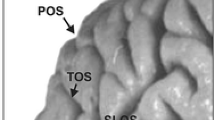Abstract
We assessed reproducible definition of two standardized co-ordinate systems for intersubject analysis of brain images. The baselines in the two co-ordinate systems were a modification of the canthomeatal (inCM) line and the anterior-posterior commissural )AC-PC) line. Axial spin-echo MR images of four subjects at 1.5T were used. Operator error was computed from the replicate analyses of two operators. The mCM line was determined by the lens of the eye and the internal auditory canal, and the AC-PC line was determined by the intersection of the AC and PC with the interhemispheric fissure. Reproducibility of the mCM markers (SD=0.59 mm) did not differ significantly from that of the AC-PC line (SD=0.68 mm). The measurement error of the angle of the baseline (δα), however, was more than 7 times as large for the AC-PC line as for the mCM line. An additional error affecting the rostrocaudal rotation of the co-ordinate systems, attributable to the distance between the anatomic markers, was 2.1 and 3.6° (3 mm and 5 mm slice thickness) for the mCM co-ordinate system and 8.2 and 11.0° (3 mm and 5 mm slice thickness) for the AC-PC system. The AC-PC line based co-ordinate system is therefore, less reproducible than the mCM line based system. this could be improved if a combination of axial and sagittal images were used for the definition of the AC-PC line.
Similar content being viewed by others
References
Luzzati C, Scotti G, Gattoni A (1979) Further suggestions for cerebral CT localization. Cortex 15: 483–490
Talairach J, Szikla G, Tournoux P, Prosalentis A, Bordas-Ferrier M, Covello L, Iacob M, Mempel E (1988) Atlas d'anatomie stéréotaxique du telencéphale. Masson, Paris
Takase M, Tokunaga A, Otani K, Horie T (1977) Atlas of the human brain for computed tomography based on the glabella-inion line. Neuroradiology 14: 73–79
Tokunaga A, Takase M, Otani K (1977) The glabella-inion line as a baseline for CT scanning of the brain. Neuroradiology 14: 67–71
Mazziotta JC, Pelizzari CC, Chen CT, Bookstein FL, Valentino D (1991) Region of interest issues: the relationship between structure and function in the brain. J Cereb Blood Flow Metab 11: A51-A56
Pelizzari CA, Chen GTY, Spelbring DR, Weichselbaum RR, Chen CT (1989) Accurate three-dimensional registration of CT, PET and/or MR images of the brain. J Comp Assist Tomogr 13: 20–26
Sandor T, Jolesz F, Tieman J, Kikinis R, Jones K, albert M (1992) Comparative analysis of computed tomographic and magnetic resonance imaging scans in Alzheimer patients and controls. Arch Neurol 49: 381–384
Sandor T, Albert MS, Stafford J, Harpley S (1989) Use of computerized CT analysis to discriminate Alzheimer patients and normal controls. AJNR 9: 1181–1187
LeMay M, Stafford JL, Sandor T, Albert M, Haykal H, Zamani A (1986) Statistical assessment of perceptual CT scan ratings in patients with Alzheimer disease. J Comput Assist Tomogr 10: 802–809
Gado M, Patel J, Hughes CP, Danziger W, Berg L (1983) Brain atrophy in dementia judged by CT scan ranking. AJNR 4: 499–500
Arai H, Kobayashi K, Ikeda K, Nagayo Y, Ogihara R, Kosaka K (1983) A computed tomography study of Alzheimer's disease. Neurology 229: 69–77
Zatz LM, Jernigan TL, Ahumada AJ (1982) Changes on computed cranial tomography with aging. AJNR 3: 1–11
Rappoport SI (1991) Discussion of PET Workshop Reports, including recommendations of PET data analysis working group. J Cereb Blood Flow Metab 11: A140-A146
Fox PT, Perlmutter JS, Raichle ME (1985) A stereotactic method of anatomical localization for positron emission tomography. J Cereb Blood Flow Metab 9: 141–153
Bergstrom M et al. (1981) Head fixation device for reproducible position alignment in transmission CT and positron emission tomography. J Comp Assist Tomogr 5: 136–141
Evans AC, Marrett S, Collins L, Peters TM (1988) Anatomical functional correlation using an adjustable MRI based atlas with PET. J Cereb Blood Flow Metab 8: 813–830
Friston KJ, Passingham RE, Nutt JG, Heather JD, Sawle GV, Frackowiak RSJ (1989) Localisation in PET images: direct finding of the intercommissural (AC-PC) line. J Cereb Blood Flow Metab 9: 690–695
Steinmetz H, Furst G, Freund HJ (1989) Cerebral cortical localization: application and validation of the proportional grid system in MR imaging. J Comp Assist Tomogr 13: 10–19
Ferguson GA, Takane Y (1989) Statistical analysis in psychology and education. McGraw Hill, New York, p 204
Author information
Authors and Affiliations
Rights and permissions
About this article
Cite this article
Sandor, T., Tieman, J., Ong, H.T. et al. Comparison of the precision of two standardized co-ordinate systems for the quantitation of brain anatomy: preliminary results. Neuroradiology 36, 499–503 (1994). https://doi.org/10.1007/BF00593507
Issue Date:
DOI: https://doi.org/10.1007/BF00593507




